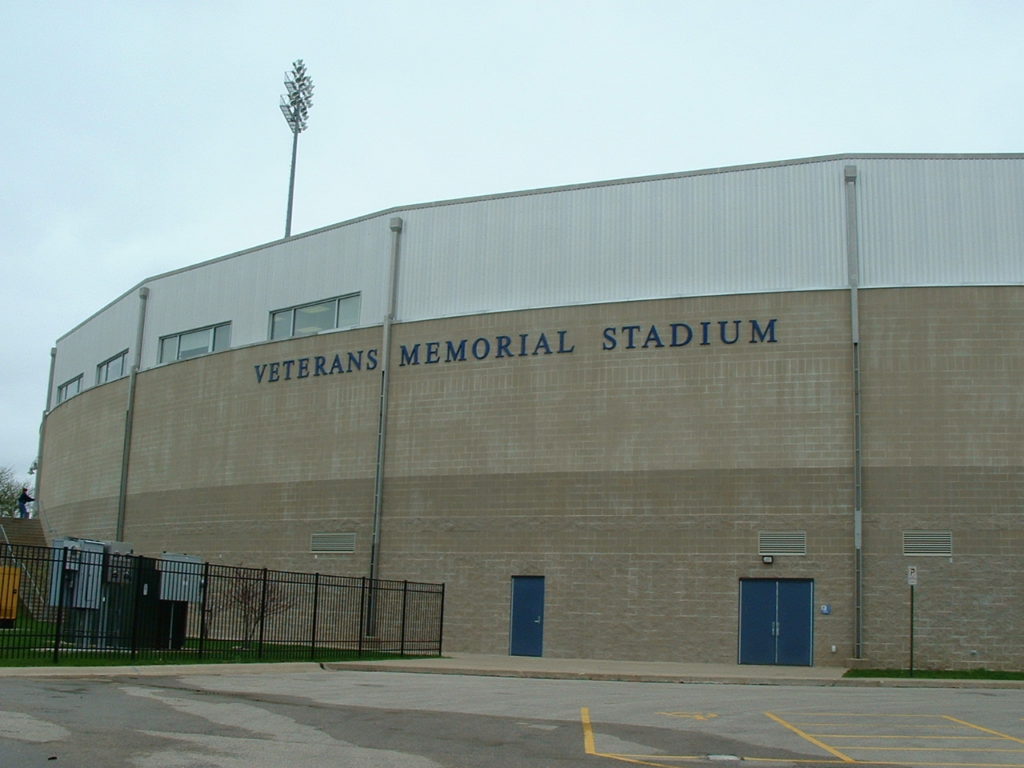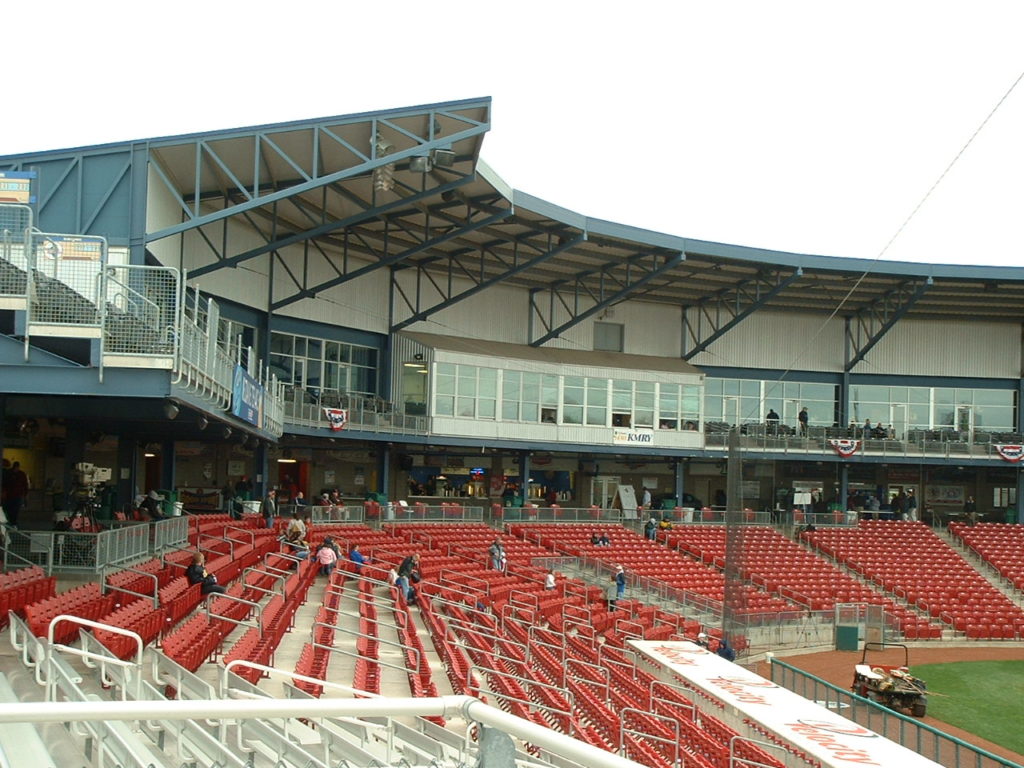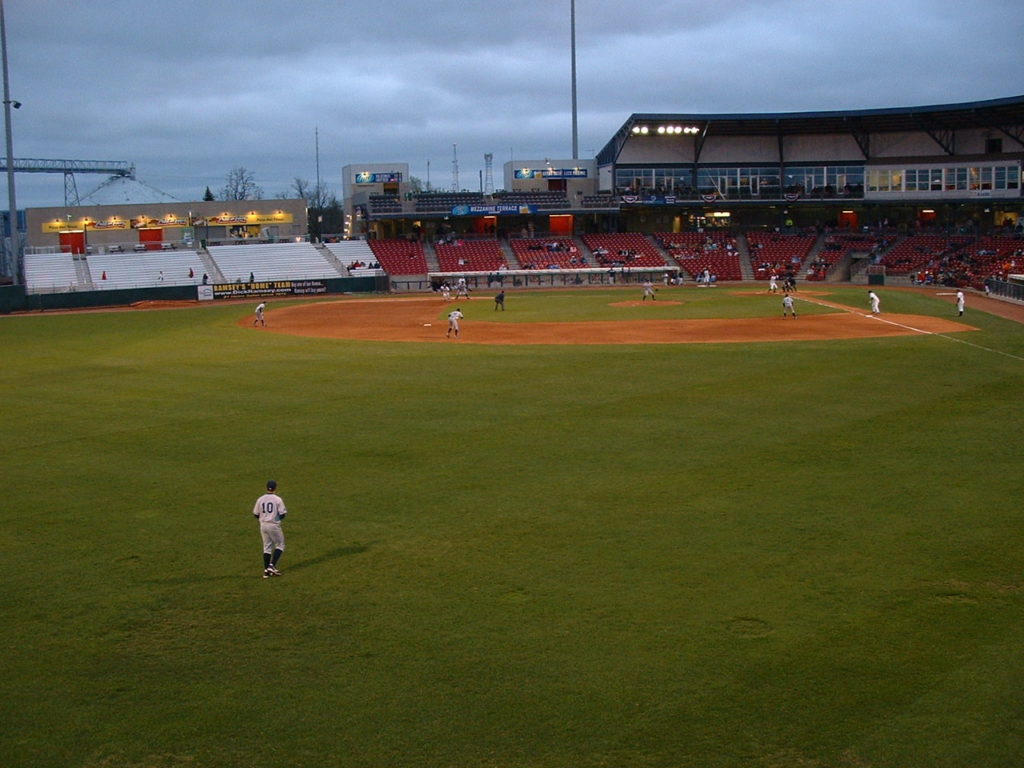It would be easy to get a sense of dread as you approach Veterans Memorial Coliseum, the home of the Cedar Rapids Kernels (Low Class A; Midwest League). The outside, a high brown-bricked area topped by aluminum in the upper echelons of the park, is rather unattractive and forbidden looking. It reminded us a bit of the outside of old Country Stadium in Milwaukee. But when you get inside the place, as was the case in that wonderful old ballpark. everything changes. This might not be the cutest ballpark you will ever visit but, as we observed in a 2002 visit, there is little doubt it was built for baseball.
FAST FACTS
Year Opened: 2002
Capacity: 5,300
Owner: City of Cedar Rapids
Architect: 360 Architecture
Cost: $16.9 million
Suites: 12
Dimensions: 315L, 378 LC, 403C, 390RC, 325R
Playing Surface: Grass
Website: kernels.com
Phone: 319/363-3887
League: Midwest League
Parent: Los Angeles Angels of Anaheim
Parking: Free. There are two main lots. The best bet is to turn left by the hockey arena and go to the football stadium. The parking lot is on the right hand side. However, you can park in a lot on Rockford Road that is near the right field side of the ballpark. There is also limited street parking. Address/Directions: 950 Rockford Rd. SW, Cedar Rapids, IA 52404. Take I-380 to exit 18 (Wilson). Go west on 16th Avenue. Go right on Rockford Road SW. The ballpark is about a mile or so on the left-hand side near to the arena.
Here is a classic example of not assigning much importance to a first impression. It would be easy to get a sense of dread as you approach Veterans Memorial Coliseum, the home of the Cedar Rapids Kernels (Low Class A; Midwest League). The outside, a high brown-bricked area topped by aluminum in the upper echelons of the park, is rather unattractive and forbidden looking. It reminded us a bit of the outside of old Country Stadium in Milwaukee.
But when you get inside the place, as was the case in that wonderful old ballpark. everything changes. This might not be the cutest ballpark you will ever visit but, as we observed in a 2002 visit, there is little doubt it was built for baseball. They have held a few concerts here (Willie Nelson and Bob Dylan came through town on their summer ballparks tour a few years ago) but that is about as far as you could stretch the place.
This is a baseball park, first and foremost. The 2006 American Legion World Series was played here. and Northern Iowa and University of Iowa played an annual “Corridor Classic” game there. The sightlines were set up with watching a ballgame in mind. As we noted below, they started playing baseball in Cedar Rapids well over 100 years ago. As now, when they serve as the Angels’ affiliate in the Midwest League, the level of play has always been in the low minors.
Veterans Memorial Stadium reflects that fact – and the comfort level of this 124,000-person community. This is a blue-collar town with a blue-collar ballpark. It’s a nice ballpark that, like the city it is located in, is larger than it looks. At the same time, it is a very comfortable place to watch a game. You won’t find the same nifty skylines here that you will in, say, Davenport or Des Moines. But you can park for free, tickets and concession prices are reasonable and the place has the feel of a favorite chair in your den.
The Kernels had a tough sell the night we arrived. It was 72 degrees at noon the day or our arrival. By gametime (6:30 p.m. in April and May), it was down to 47 degrees with a 25-mph breeze blowing in from center field. By the seventh inning, it had the feel of a college football game in November. One thing about this park: it holds the cold well. We suspect the same is true for the heat.
Ah, the joys of outdoor baseball. You just have to come prepared. Which people did. They announced about 2,000 the night of our visit. The brave souls who came were allowed to stretch out as much as they want. Like a lot of minor league parks, you can get very close to the field here. (Premier seats, which are the first several rows between the dugouts are just $9). One very unusual aspect is the berm here is in left field down the foul lines. So, you can feel a little closer to the action. Also, they did a nifty thing in the left-field corner – angling the bleachers so the pitcher is the main focus of your view. The same is true (to a lesser extent) down the right-field line.
If you opt for a reserved seat, you can get pretty close for eight or nine bucks. The main deck only goes back about 20 rows. None of the rows are particularly long. This ballpark was built for working-class people, not the Rockefellers. True, there are a dozen suites on an upper level that provide a nice view and are good places to catch foul balls. But the main crux of the place is the expansive lower level.
For a ballpark that is so wide inside, it is surprisingly narrow behind the seating area. For most games, there will be enough room to move around. However, on a crowded day, one imagines it might be a bit of tight squeeze behind home plate. The beer stands as well as various other displays that get put up take up space. It probably won’t be a major irritation but be prepared anyway.
One thing that may get your attention: the pennants noting previous players who came through Cedar Rapids. It’s a better than average list for a lower level minor league franchise, including Hall of Famers John McGraw (1891) and Lou Boudreau (1938) and such later famous major leaguers as Rocky Colavito (1951), Ted Simmons (1967), Chili Davis (1978), Trevor Hoffman (1991) and John Lackey (2000).
One thing that probably will come in handy — the grandstand roof juts out more than you see in a lot of minor league parks. There is some room for protection from the rain.
The Randy Kuehl Honfidence Pavillon in left field is a great place to take a group. It can seat more than 400 people in picnic table like seating. Even though it was a chilly night, the minor league standard hot tub was in full blast the night we were there. Locals told us it is rare game when it is not used. One thing that is new this year is a picnic area intended for group use behind the berm in left field.
There is a concession stand and bathroom facility for those groups and the Randy Kuehl occupants only. On this chilly night, the ushers cut folks some slack. But that’s what you do when somebody visits your house. You welcome them in and try to make them comfortable. It’s what they do best at Cedar Rapids. Like they used to sing about in the old soup commercial, simple pleasures are the best. Ballgames here are simple and pleasant.
In-park experience
There is a better-than-average scoreboard in right field that provided a lot of information and a good picture. Like many teams, the Kernels have in-home cameras that project game action onto the scoreboard, a capability built into the ballpark. The team did a few between inning activities that wrapped around the mascot, Mr. Shucks. The best moment of the night occurred by accident. The heavy winds blew several one-dollar bills (that were intended as part of a promotion) out of the hand of General Manager Jack Roeder and into the stands. Roeder was a good sport about it and let the kids scramble for them. Mr. Shucks stayed busy interacting with kids when he wasn’t on the field. The between-innings activities weren’t unusual but they did get done quickly and never held the game up.
CONCESSIONS
There is a decent, albeit unspectacular variety of items to choose from here. This is Iowa, where meat is what is for dinner in many households. The Kernels added a grill this year that came highly recommended. For $6.50, the steak sandwich was very tasty and was made to order. (A nearby usher said it is the best thing in the ballpark.) You can get chicken sandwiches, hamburgers and hot dogs there as well. At the main concession stand, you can have a pork tenderloin sandwich for $4.75 or a Walking Taco (Doritos, meat, cheese, lettuce) for just $4. Waffle Cones aren’t the rarity they used to be at ballparks but it is nice you can get one for $3.50. There is also plenty of beer choices, ranging in price from $4-5.50. On this night, coffee was doing a booming business. The concession workers won some brownie points for refilling coffee orders for free as people struggled with the sharp winds.
SOUVENIRS

The Bimm-Diamond Store, located between home and third base behind the main grandstands, isn’t very big and didn’t have as much variety as you would see in other places. But what they had was pretty good stuff. Everything looked of good quality and the place was very clean. A hooded sweatshirt for $40 fit perfectly and felt wonderful. There wasn’t much material related to the parent club but Anaheim seems like another world compared to Cedar Falls. The staff was very patient as folks wandered slowly through the store. They knew most of them were taking a break from the cold but, as long as they weren’t getting into mischief, they didn’t care. One area worth a visit is a display in the corner with old pictures of past teams and players and some nifty memorabilia.
HISTORY
As we noted earlier, Cedar Rapids was one of the first Iowa cities to play pro baseball, playing in the Western Association in 1896-97 and 1899. The Cedar Rapids has been in the Midwest League since 1962. Prior to this current streak, there were four Cedar Rapids teams in the Three-I League: the Rabbits (1901-1909, 1920-1921), Raiders (1938-1942, 1957), Indians (1950-1954) and Braves (1958-1961). In addition, the Cedar Rapids Raiders played in the Western League in 1934-1937.
When Cedar Rapids joined the Midwest League in 1962, it was known as the Red Raiders, but quickly the team took on the monikers of parent teams: the Cardinals (1965-1972), Astros (1973-1974), Giants (1975-1979), and Reds (1980-1992). Coincidentally, when the Angels began to supply players, the team followed the lead of many other minor-league teams and took on their own distinctive nickname. Although their last Midwest League title came in 1994, the Cedar Rapids usually has fielded respectable teams. Going into the 2008 season, they were just 53 games under .500 all-time (2,959-3,013). Most of these teams played in the original Veterans Memorial Stadium, built in 1949 in the same location as the current park.
BEFORE/AFTER THE GAME
You’re in the heartland of America, so you’d do well to spend some time visiting the places that make it unique. The Amana Colonies are a group of seven villages southwest of Cedar Rapids where the early inhabitants, the Inspirationalists, settled in 1855. The Inspirationalists originated in Hessen, Germany, and was a Lutheran splinter group whose members believed that God spoke directly to them while they were in a trance. As a result of these missives from God, the Inspirationalists first came to upper New York State in 1842 before buying 26,000 acres in central Iowa. The Inspirationalists believed strongly in communal life, so all the land as well as the buildings and businesses were owned by the community, and members were assigned to specific jobs and living quarters based on the will of the community. Their way of life lasted until 1932, when the community voted to disband the communal aspects of living, but they maintained a corporation, Amana Society, to oversee their business interests and Amana Church Society to oversee their spiritual interests.
Today, the Amana Colonies are on the National Register of Historic Places. Many of the communal spaces, such as worship areas and communal kitchens, have been converted to museums, while other buildings have been converted to businesses. The Amana Colonies were always known for their high level of craftsmanship, and today you can find well-made furniture, food, and clothing. (Yes, Amana appliances did originate in the Amana Colonies, and there is still a plant there.)
Although there are seven Amana villages, truth be known only two of them are really essential visits: Homestead and Amana.
Other stores and restaurants worth checking out in Amana: the Ronneburg Restaurant, the Ox Yoke Inn, the breakfasts at the Colony Restaurant, the Amana Meat Shop and Smokehouse, and the Millstream Brewing Company, where you can find a good selection of German-style beers and root beers. There are also a host of wineries in the area, but before you get all excited about visiting Iowa’s version of Napa Valley, note that grapes are not exactly plentiful in central Iowa and that the original members of the Amana Colonies used pretty much anything available — honey, peach, black raspberry, rhubarb, dandelion, apricot — to create wine.
Cedar Rapids is not known as being a center for nightlife in Iowa. You don’t have to go far to find fun after a game. You can simply march across the street to the Stadium Lounge, which stays open until 2:00 a.m. Excellent beer for a good price. They advertise their chicken as a house specialty. Truth be told, it looked like a lot of food. If you want to get away from the ballpark, there’s a Czech Village along 16th Av. SW. where you can find Czech restaurants and bars like Zindrick’s and Al’s Red Frog. The latter offers a large variety of sandwiches, subs and pizzas.
WHERE TO STAY
The ballpark is south of downtown and there are no hotels nearby. Your best is to pick one close to I-380. We stayed at a Comfort Inn on 33rd Ave about four miles overall from the park that was just fine. There were several other choices in the same price range nearby.






